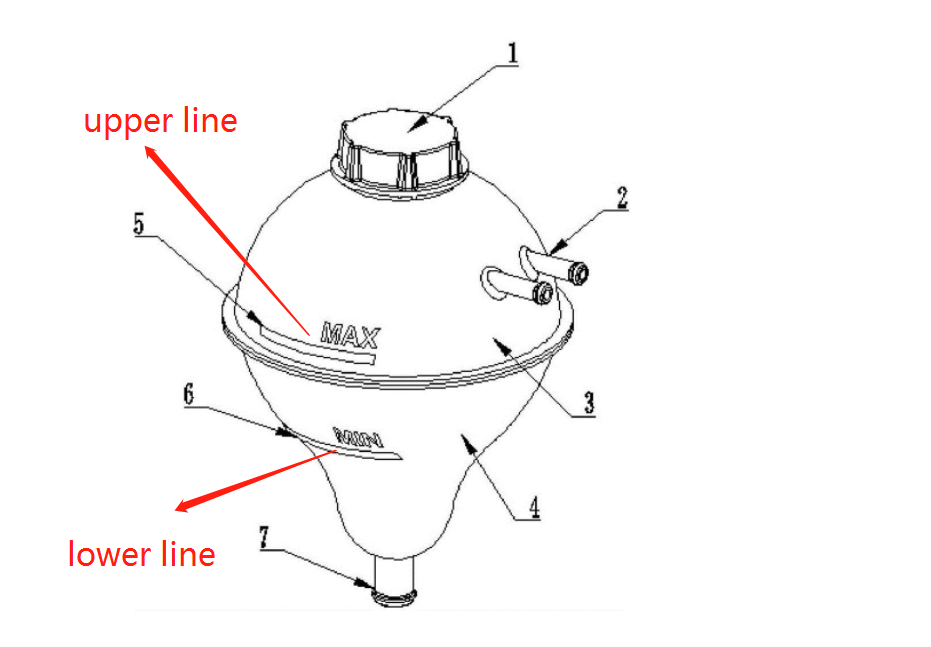1.coolant expansion tank function
1) Provide an expansion space for the coolant in the cooling circuit (i.e. as an expansion chamber), separate the coolant from the air, drive off the gas in the water circuit, and eliminate the air resistance of the coolant.
2) Hold the coolant overflowing from the radiator and make it flow back into the cooling system to prevent the decrease of the coolant in the cooling system.

2.coolant expansion tank how it works
When the heat load of the engine reaches a certain level, the internal pressure of the cooling system exceeds the opening pressure of the steam valve of the water tank cover, the steam valve opens, and the steam-water mixture in the radiator flows into the expansion tank through the steam condensation pipe connected to the radiator overflow pipe.
When the heat load of the engine decreases, the pressure in the cooling system gradually decreases, and the volume of the coolant and residual gas in the system decreases. At this time, the steam valve of the water tank cover is closed; when the pressure in the system reaches a certain degree of vacuum, under the action of the pressure difference, The intake valve of the cover is sucked open, and the coolant in the expansion tank returns to the upper water chamber of the radiator along the steam condensing pipe under the action of the atmosphere, participates in the cooling cycle, and keeps the liquid level in the water tank constant.
Like all automobile internal combustion engines, it is inevitable to have gas in the cooling system, but when the accumulated gas exceeds a certain limit, it will have an adverse effect on the operation of the engine, such as causing a decrease in the flow rate of the water pump, resulting in a decrease in cooling efficiency; Partial overheating in the body will cause engine power loss, economical deterioration, and even malfunction; in addition, when the engine is shut down in a hot state, because the coolant stops circulating, the overheated parts dissipate heat and cause the coolant to partially boil. Under the above circumstances, the cooling liquid will be lost, and the expansion tank device and the water tank cover are used together to solve the problem of supplementary storage and overflow storage (recycling) of cooling liquid in the cooling system

3.Thickness for coolant expansion tank
The wall thickness of the overflow tank should be 3mm. The body material of the overflow tank should be PP. The unmarked dimensions should be subject to the 3D digital model. The parts should have no burrs and sharp corners, and the outer surface should be free from deformation, sink marks and scratches.
4.Open pressure for coolant radiator overflow tank
Positive opening pressure is 108Kpa; negative pressure opening pressure is 0kpa~-10kpa
5.Sealing test requirements for expansion tank
Plug the overflow tank assembly except for the return air hole and the mouth of the pot. Under the pressure of 101kpa, the overflow tank assembly will not leak for 60 seconds.
6.loosening and tightening torque for expansion tank
1.5N.m~4.5N.m apply for thigh or loosen the coolant radiator expansion tank.
7.burst test for expansion test
The coolant expansion tank need to withstand 200kpa burst pressure.
8.Vibration test for coolant overflow tank
The test medium is water: coolant = 1:1, the coolant is installed to the max line of the overflow tank, the acceleration is 4G, the frequency is 10~20Hz, the number of vibrations is 3×106 times, the overflow tank assembly has no cracks and leakage
9.Low temperature test for coolant overflow tank
Install the overflow tank assembly in the high and low temperature chamber, fill with 50% antifreeze to the Max line, cool down to -40°C, and keep it for 24 hours; finally conduct a leak test, and the overflow tank assembly has no leakage.
10.High temperature test
Install the overflow tank assembly in the high and low temperature chamber, fill with 50% antifreeze to the Max line, and keep it at 115°C for 24 hours; the overflow tank assembly has no deformation or rupture.
The expansion tank is a sub-component of the cooling system, if you need a customized radiator, please contact us Fiter-Auto
